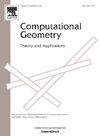恐高卫兵瞭望塔问题
IF 0.4
4区 计算机科学
Q4 MATHEMATICS
Computational Geometry-Theory and Applications
Pub Date : 2023-02-01
DOI:10.1016/j.comgeo.2022.101918
引用次数: 0
摘要
在多面体地形的恐高警戒瞭望塔问题中,在塔顶放置一个方形的轴向平台,塔顶的下端点位于地形表面。在标准的瞭望塔问题中,目标是最小化瞭望塔的高度(即长度),这样从位于塔顶的平台上就可以微弱地看到地形表面上的每个点。在本文中,我们证明了在R2中该问题可以在O(n)时间内解决,而在R3中则需要O(nlog (n))时间,其中n是地形的顶点总数。本文章由计算机程序翻译,如有差异,请以英文原文为准。
Acrophobic guard watchtower problem
In the acrophobic guard watchtower problem for a polyhedral terrain, a square axis-aligned platform is placed on the top of a tower whose bottom end-point lies on the surface of the terrain. As in the standard watchtower problem, the objective is to minimize the height (i.e., the length) of the watchtower such that every point on the surface of the terrain is weakly visible from the platform placed on the top of the tower. In this paper, we show that in the problem can be solved in time, and in it takes time, where n is the total number of vertices of the terrain.
求助全文
通过发布文献求助,成功后即可免费获取论文全文。
去求助
来源期刊
CiteScore
1.60
自引率
16.70%
发文量
43
审稿时长
>12 weeks
期刊介绍:
Computational Geometry is a forum for research in theoretical and applied aspects of computational geometry. The journal publishes fundamental research in all areas of the subject, as well as disseminating information on the applications, techniques, and use of computational geometry. Computational Geometry publishes articles on the design and analysis of geometric algorithms. All aspects of computational geometry are covered, including the numerical, graph theoretical and combinatorial aspects. Also welcomed are computational geometry solutions to fundamental problems arising in computer graphics, pattern recognition, robotics, image processing, CAD-CAM, VLSI design and geographical information systems.
Computational Geometry features a special section containing open problems and concise reports on implementations of computational geometry tools.

 求助内容:
求助内容: 应助结果提醒方式:
应助结果提醒方式:


